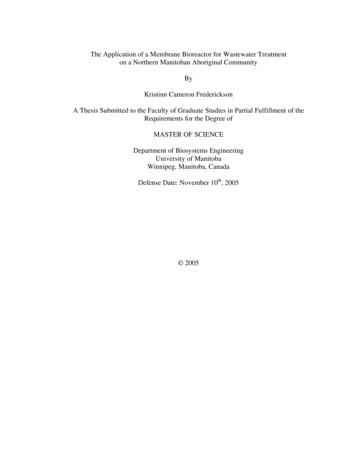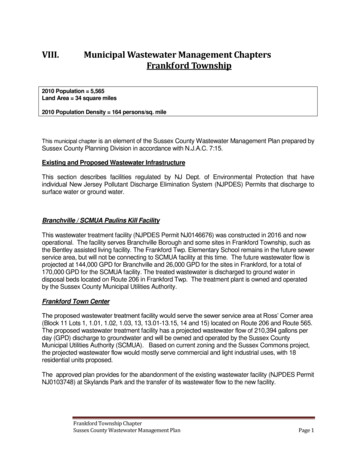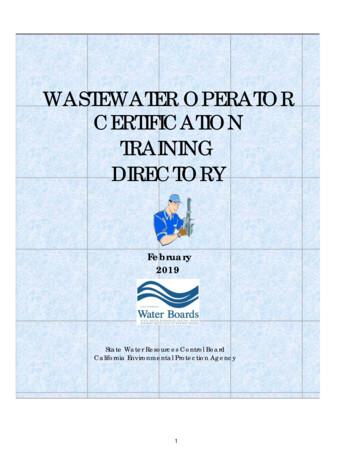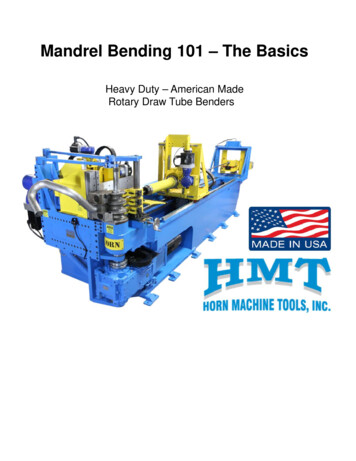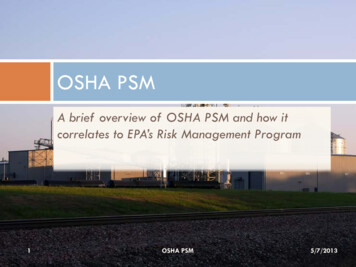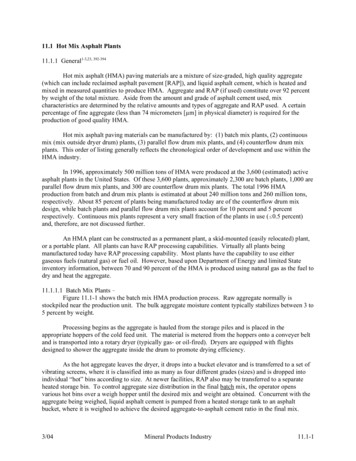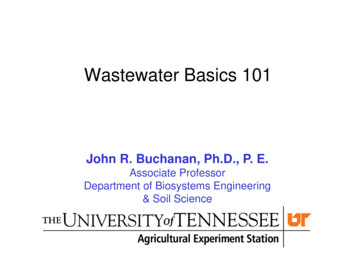
Transcription
Wastewater Basics 101John R. Buchanan, Ph.D., P. E.Associate ProfessorDepartment of Biosystems Engineering& Soil Science
Wastewater Basics 101 Target audience– policy makers, leaders, and planners– People who have a water quality agenda This presentation discusses the fundamentalsof converting wastewater back to water– How do we (humans) interact with thehydrologic cycle
Wastewater Basics 101 Major Focus– What is in wastewater and how do we get itout– Organic matter, nitrogen, & phosphorus Minor Focus– Individual and small community wastewatertreatment systems Wastewater basics are universal Independent of scale
Wastewater By definition (for today’s purpose)– Water that has constituents of human and/oranimal metabolic wastes– Water that has the residuals from cooking,cleaning and/or bathing Thus,– Domestic wastewater Our focus is wastewater that comes from a home
Wastes and Water The more water youhave,– The morewastewater yougenerate– Romans knew thatwater carried awaythe smell
Wastes and Water If water is notavailable– Then wastewater isnot generated– The original lowflush toilet
Carriage Water There is no other substance that cantransport wastes like water can– it cleans the inside of our body– it cleans the outside of our body– it carries away our metabolic wastes In high population densities– water is the best means to collect andtransport waste away
Water is the Universal SolventDepartment of Biochemistry and Molecular BiophysicsThe University of Arizona
Water is Dense and has Viscosity Water is heavy– provides for buoyancy– provides for inertiaforces Water is viscous– can suspend items– can erode surfaces
So, our Chore is to Get Wastesout of Water Is it difficult to get waste out of water?– Yes, but we have a lot of help available to us– Our team includes GravityDrivers of the hydrologic CycleThe sunUltimate DecomposersBillions of microorganismsThe basis for all wastewater treatmentAnd, the soil
Wastewater By weight– Is 99.9% water– It is the 0.1% that we have to remove That 0.1% contains– Organic matter– Microorganisms (a few of which are pathogenic)– Inorganics compounds
Major Measures ofWhat’s in Water Oxygen Demand– Biochemical oxygen demand– Chemical oxygen demand Indicator organisms– Fecal coliform– Escherichia coli(E Coli 0157:H7 is the really bad boy) Solids content– Total suspended solids– Total dissolved solids
Other Measures ofWhat’s in Water Chemical analyses––––Ammonia & nitrateTotal & reactive phosphoruspHAlkalinity Volatile compounds– Dissolved gases– Odors
Oxygen Demand Indictor of mass of dissolved oxygen neededby microorganisms to degrade organic andsome inorganic compounds– High BOD/COD is indirect indicator of theorganic content– Ammonia is inorganic and creates an oxygendemand As it is converted to nitrate
Aerobic Biotransformation Dissolved oxygen is consumed in the processof convert organic matter into inorganicmatteraerobicOrganic Carbon O2 Energy CO2 H2O Residuemicroorganisms O2new aerobicmicroorganisms O2Energy CO 2 H2O Residuenew aerobicmicroorganisms Energy CO2 H2O Residue
Organic Matter Contains more than– Carbon, hydrogen, and oxygen Can also contains––––NitrogenPhosphorusSulfurMany other compounds
Degradation of Organic Matter Releases these other compounds– Typically in an inorganic form For example– Nitrogen becomes ammonia/ammonium Creates an additional oxygen demand– Phosphorus becomes ortho-phosphate
Nitrogen Cycle Nitrogen is a component of protein– As proteins are degraded, nitrogen is released– Nitrogen converts to ammonia/ammonium– Process of ammonificationOrganic-N Microorganisms NH3/ NH4
Biological Nitrification Ammonia/ammonium is then converted tonitrite and nitrate– Nitrification– Oxygen demand Nitrification is a two-step autotrophic process– the conversion from ammonium to nitrateStep 1:NH4 Nitrosomonas 3/2O2 NO22- 2H H2OStep 2:NO2-Nitrobacter 1/2O2 NO3-
Okay, Let’s go Back to theBigger Picture We focused on oxygen demand– We have wastewater with organic matter– And other stuff However, the first treatment step– Is liquid/solid separation– Very inexpensive energy source– Very large return on investment In terms of treatment
Preliminary/Primary Treatment Gravity as a treatment method Floaters and Sinkers (go ahead and giggle)– Based on buoyancy Water is very dense – many waste products float– Paper products– Fats, oils, grease Some organic solids are more dense than waterand sink– Bacterial cells– Food wastes
Small System Primary TreatmentLIDSRISERSINLET TEESCUMCLEAR LAYERSLUDGEOUTLET TEEW/ EFFLUENTSCREEN
Basic Assumptions 50% reduction in oxygen demand– Because organic solids remain in tank– Creates an accumulation in the tank That is either very slow to degrade Or will not degrade Tremendous reduction in suspended solids Minimal biotransformation– Anaerobic environment
Now, Let’s Remove the Remainderof the Oxygen Demand Secondary treatment– the second major process– Provide dissolved oxygen to aerobicmicroorganism to finish the job Two questions– How much land is available?– How much energy are you willing topurchase?
Providing Dissolved Oxygen Air is only 21% ( /-) oxygen– Have to move a lot of air through water totransfer the oxygen– Oxygen readily dissolves into water Passive – large footprint, low energy– Moving air over water allows for transfer Mechanical – small footprint, much energy– Moving air through water for enhanced transfer
Secondary Treatment Devices The soil––––Attached growthPassive aerationLow loading rateExcessive growth ofbiosolids isproblematic Trickling filters– Attached growth– Passive aeration– biosolids can slougth Activate sludge– Suspended growth– High loading rate– Activated sludge isthe biosolids– Mechanical aeration
Okay, Inventory Time After secondary treatment and clarification– We have reduced oxygen demand Oxidized the organic carbon Converted organic nitrogen to nitrate– Clarified the effluent– Put a hurt on the microbial population If nutrients are not an issue– We can now disinfect if surface discharged
If Nutrients are an Issue Tertiary treatment – the third major process– Nutrient removal– Some references include disinfection Nitrate and phosphate– Required nutrients for plant growth– Excessive plant growth Creates an oxygen demand Crowds out other aquatic organisms
Denitrification NO3- can be reduced,– under anoxic conditions, to N2 gas throughheterotrophic biological denitrification– Two issues Anoxic conditions Heterotrophic bacteria
Anoxic Conditions Classical definition– Very low concentration of dissolved molecularoxygen (i.e., anaerobic) Forces the use of chemically-bound oxygen– Dissolved organic carbon is available Heterotrophic bacterial use organic carbon as foodsource
Biological Denitrification Totally cool process– Nitrate has oxygen– Through reduction/oxidation processes Oxygen is pulled from nitrate ion Nitrogen evolves as a gas formHeterotrophic BacteriaNO3- Organic Matter N2 CO2 OH- H2O
Operational Issues Here is the rub– we consumed the organic carbon in theprevious step– Under aerobic conditions Thus, our process must– Remove dissolved oxygen– Add organic carbon back into solution
Recirculation Recirculate a fraction of the– Secondary treated water back through primarytreatment Assumptions– Nitrates are formed during secondarytreatment– Organic carbon is available in primarytreatment– Raw wastewater is anaerobic
Phosphorus Removal Chemical treatment– Phosphate is an anion: PO43– Cations can be added to bind with phosphate Ca2 Al3 Fe3 – Naturally occurs in soil systems Except sandy soils– Each form an insoluble precipitant
Phosphorus Removal Biological Methods– Encourage the luxurious uptake of phosphoruswithin microbial cells– Harvest the cells before the excessphosphorus is released– Requires very controlled conditions
Future Wastewater Treatment Pharmaceuticals and Personal Care Products– what other “stuff” goes down the drain with ourwastes– medicines, hormones, antibacterial soaps– many of these products are not removed withtraditional means. Will we call this “quaternary treatment”?
So, the Ultimate Question . At what point does wastewater becomewater?– are you willing to consume recycled water? you are consuming recycled water it’s called the hydrologic cycle– but, the cycle is getting smaller civilization will have to adapt to the notion of theirbeing a direct connection between the wastewatertreatment plant and the water treatment plant
Questions?
in wastewater and how do we get . it . out – Organic matter, nitrogen, & phosphorus Minor Focus – Individual and small community wastewater treatment systems Wastewater basics are universal Independent of
